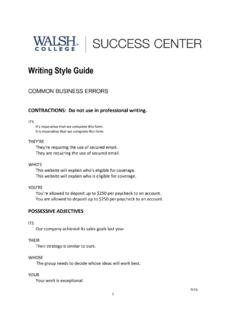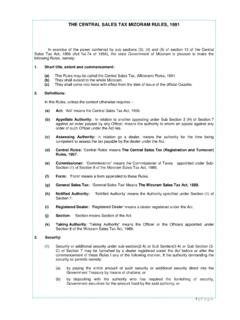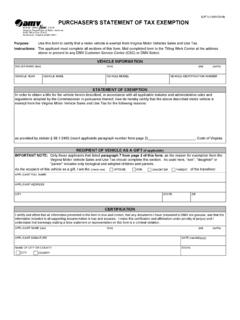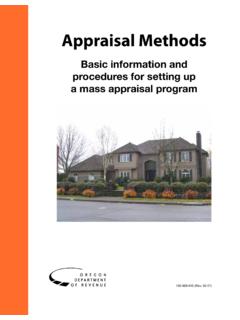Transcription of A UNIFORM SYSTEM OF FEDERAL TAX CITATIONS, …
1 A UNIFORM SYSTEM OF FEDERAL TAX CITATIONS, Second Edition Walsh College Department of Accounting and Taxation Troy, Michigan By: Mark R. Solomon Daniel S. Hoops Copyright 2013 Walsh College i TABLE OF CONTENTS Topic Page Forward ii Preface iii Primary Sources 1 Statutes 1
2 Legislative Materials 5 Administrative Precedents 6 Judicial Precedents 13 Secondary Sources 19 Tax Services 19 Treatises and Textbooks 20 Law Reviews 20 Other Journals and Periodicals 21 Proceedings Reports 22 Internet Sources 23 Citation Usage 24 Official Citations of the Tax Court and Internal Revenue Service 24 Order of Citation 24
3 Use of Signals 25 Short Forms for Citation Repeats 25 Conclusion 26 ii FOREWORD On March 9, 2013, Mark Solomon passed away at the age of 67. Professor Solomon joined Walsh College as an adjunct instructor of taxation in 1976, and became chair of the Taxation and Business Law Department in 1981. In the ensuing years, he strengthened the Master of Science in Taxation (MST) degree's academic rigor, resulting in national recognition among MST alumni and tax professionals.
4 Professor Solomon also took exceptional pride in each MST alumni member's promotion and professional success. Professor Solomon inspired, encouraged, and awed students with his consummate mastery of tax law. With high classroom standards and attention to detail, he encouraged and inspired students to think like the tax professionals they would ultimately become. At graduation, students sought Professor Solomon out to shake his hand and thank him for setting the bar so high. In addition to his legacy as a faculty member, Mark was a true student of taxation himself. Mark was the steward of the Walsh College Tax Library, which boasts one of the largest collections of tax-related materials in the Midwest.
5 Mark was also the driving force behind the Tax Portal that provides access to over 600 tax-related Internet links. Ever the perfectionist and student of tax research, Prof. Solomon developed the original edition of A UNIFORM SYSTEM of FEDERAL Tax Citations in 1982 as a guide for Walsh MST students. The Second Edition of A UNIFORM SYSTEM of FEDERAL Tax Citations is the product of many discussions Mark Solomon and I had about updating the original SYSTEM to incorporate the various resources that are now available to students and practitioners. I greatly appreciate the assistance of Diane Barrantes and Prof.
6 Eric Skinner for their advice and assistance in improving this Second Edition. Sadly Mark is unable to see the completed results of the Second Edition. Daniel S. Hoops, 2013 iii PREFACE It is often said that the mark of an educated person is the manner in which that person speaks and writes. Perhaps so and perhaps not. What is clear, however, is that many people judge the education (and sometimes the competence) of another, whether rightly or wrongly, by that other person s command of the written and spoken word. The tax world differs little from the rest of the world in this regard.
7 Regardless of whether the use of a speaking-writing standard is appropriate, to say nothing of whether or not it is fair , many a judgment is made about the quality of a tax person by the quality of their tax-speak . The purpose of this text is to set forth a UNIFORM standard of one aspect of tax-speak tax citation form. What follows is intended as an in-depth (albeit non-exhaustive) review of proper citation form for the most common and most frequently cited tax materials. It goes without saying that historically tax writers have used a variety of forms of citation (indeed, every tax publisher seems to have their own version), none of which can be explicitly designated as right or wrong.
8 There is, therefore, some modest need among tax practitioners and especially among tax students for a useful guideline to the maze of tax citation systems in current use. The UNIFORM SYSTEM of FEDERAL Tax Citations which follows has been prepared with a view to following, insofar as seems sensible, the SYSTEM or systems most widely in use by outstanding tax scholars. Since the SYSTEM , while comprehensive, is not exhaustive, matters not covered in the SYSTEM should be cited in accordance with the rules set forth in A UNIFORM SYSTEM of Citation, Twelfth Edition, Harvard Law Review Association, Cambridge, Massachusetts (1976) (hereinafter, the Harvard Citation SYSTEM ).
9 It should be noted that many of the rules contained in this text differ markedly in form from the rules given in the Harvard Citation SYSTEM . The differences are deliberate and reflect practices common in the tax bar and among other tax practitioners. In a few cases where the logic of the situation dictates, new forms of citation have been introduced. Also worth mentioning is what is not covered herein. No attention is given to proper form for footnotes (other than the form of citation within a footnote), tables of contents, bibliography format, organization of papers, styling of papers, or the use of captions all topics of substantial importance in the writing of papers.
10 The student is urged to consult the popular style manual by Kate L. Turabian, A Manual for Writers of Term Papers, Theses, and Dissertations, Fourth Edition, University of Chicago Press, Chicago, Ill. (1973) for further consideration of those important and often neglected matters. Mark R. Solomon, 1982 1 A UNIFORM SYSTEM OF FEDERAL TAX CITATION PRIMARY SOURCES I. Statutes A. United States Constitution References to the United States Constitution are by article, section, and clause number or by amendment. Ex. 1: , , Ex. 2: amend. XVI. B. Internal Revenue Code of 1986 When used in a textual context for the first time, refer to the cited section followed by the Internal Revenue Code of 1986, as amended, then (hereinafter the Code ).





